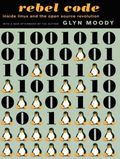 Back in 2001, Glen Moody published the first edition of “Rebel Code”, a book about the early days of Open Source and Free Software in general and about the creation of Linux in particular. It might seem strange to do a book review almost 15 years later but it’s a great historic document telling the story of how things came together in the 1990’s. The first part of the book focuses on the young Linus Torvalds and how the first Linux kernel version made it to the Internet. The second part of the book then looks at how the Linux kernel evolved in the mid 1990’s and its role as the “missing link” in Richard Stallman’s Free Software Foundation that completed the Free Software world for the first time. The third part of the book then looks at how graphical user interfaces, web browsers and end user applications not only for nerds came to the Linux world at the end of the 1990’s. A great read and I can fully recommend it for those who would like to find out more about open source history and do so from a historic point of view. Both print and e-book editions are (still) available so the book is still easy to get.
Back in 2001, Glen Moody published the first edition of “Rebel Code”, a book about the early days of Open Source and Free Software in general and about the creation of Linux in particular. It might seem strange to do a book review almost 15 years later but it’s a great historic document telling the story of how things came together in the 1990’s. The first part of the book focuses on the young Linus Torvalds and how the first Linux kernel version made it to the Internet. The second part of the book then looks at how the Linux kernel evolved in the mid 1990’s and its role as the “missing link” in Richard Stallman’s Free Software Foundation that completed the Free Software world for the first time. The third part of the book then looks at how graphical user interfaces, web browsers and end user applications not only for nerds came to the Linux world at the end of the 1990’s. A great read and I can fully recommend it for those who would like to find out more about open source history and do so from a historic point of view. Both print and e-book editions are (still) available so the book is still easy to get.
While I knew some of the stories, the book puts all of them in context and into a bigger picture. In other words, it made a lot of things a lot clearer for me. I’ve been asking myself a lot why Linux was not part of my university life back in the mid 1990s and the book makes it quite clear as well. I have to admit I’m a GUI sort of computer guy and there simply was no usable graphical user interface for Linux before 1998 (sorry, everything before KDE and GNOME was not usable for anything else than showing xterm windows…). In contrast, Windows 3.1 and later versions were on the market since 1991, which is about the time I bought my first IBM compatible PC. In other words until 1998 there was no incentive for me whatsoever to even consider something other than Windows. After university and my first job in a small company I joined Nortel as a programmer and was given an HP Unix machine for software development development with a really ugly Motiv based GUI. Compared to Windows it was stone age and I thought I actually had an old machine. But I know realize that looking at it from a Unix world point of view it was actually state of the art then. That didn’t really encourage me to look into the Linux world, either.
But things kept evolving and KDE and GNOME made a real step forward in the 2000s., i.e. only after the book was already written. In addition, StarOffice, closed source at first, also became open source at some point during that timeframe as well. For me having a usable desktop and a usable office suite in addition to an easy way to install a Linux distribution were the final pieces of the puzzle that had to come into place before I would even think about experimenting with Linux. Replacing Windows was actually not my goal at first when I finally started experimenting with Linux in 2008/9 on a netbook. Agreed, I got to the open source side of things very very late but since then it has been an incredible ride and I quickly realized that everything was in place for me to ditch proprietary and closed source software for good. Just last year I kissed the last Windows box at home good bye and I haven’t looked back since.
So that’s how the book’s story continued for me and I’m happy that I know a lot more now of how things evolved up to the point when I started to discover them. Two thumbs up!